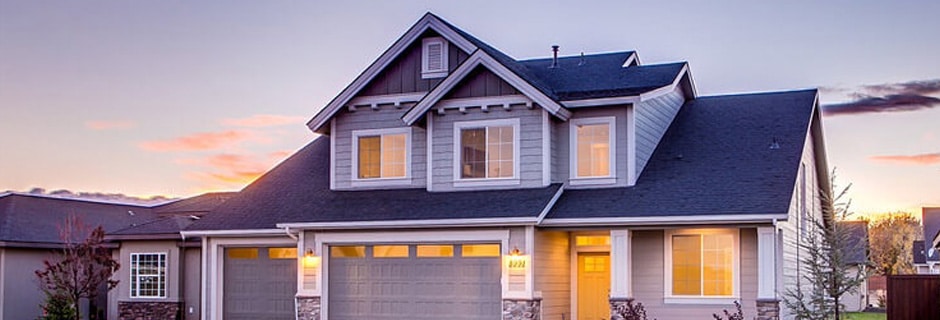The Origins of Asphalt Shingles
Asphalt shingles are an American invention first introduced in 1901. By 1939, over 11 million squares of shingles were produced. The forerunner of these shingles was first developed in 1893 and called Asphalt Prepared Roofing. This was similar to asphalt roll roofing without the surface granules. In 1897 slate granules were added to the surface to make the material more durable. Types of granules tested have included mica, oyster shells, slate, dolomite, fly-ash, silica, and clay. In 1901 this material was cut into strips for use as one-tab and multi-tab shingles. All shingles were organic with the base material called felt being primarily cotton rag. In the 1920’s cotton rag became more expensive and alternative materials were used.
Two types of base materials are used to make asphalt shingles:
Organic Shingles
Organic shingles are made with a base mat of formerly living (organic) materials such as waste paper, cellulose, wood fiber, or other materials saturated with asphalt to make it waterproof. Then a top coating of adhesive asphalt is applied and ceramic granules are embedded.
Fiberglass Shingles
A glass fiber reinforcing mat is used as a base layer for fiberglass shingles. The mat is made from wed, random-laid fiberglass bonded with urea-formaldehyde resin. The mat is coated with asphalt containing mineral fillers, making the fiberglass shingle waterproof. Fiberglass shingles typically obtain a class “A” fire rating as the fiberglass mat resists fire better than organic or paper mats.
A Formerly-Living Organic Base and Fiberglass Base
Both organic base and fiberglass base shingles are made in a similar manner with asphalt or modified-asphalt applied to one or both sides of the asphalt-saturated base. Slate, schist, quartz, vitrified brick, stone, or ceramic granules are then applied to the base, with the back side being treated with sand, talc, or mica to prevent the shingles from clinging to each other before use.
The top surface granules block ultra-violet light which causes the shingles to deteriorate. It also provides some physical protection of the asphalt and gives the shingles their color.

What to look for when installing a new roof:
Asphalt shingles have varying qualities which help them survive wind, hail, fire damage, and discoloration. Asphalt shingles come in a variety of forms and textures, including 3 tab, jet, trademark cut, t-lock, tie lock, and more. Read on to learn more about how shingles have evolved over the last 100 years!
Architectural Shingles
Architectural Shingles are multi-layered, laminated shingles that offer a more varied and contoured visual effect to the roof. These shingles are designed to avoid repetitive patterns in appearance. The eaves, starting course, and ridge caps all require special shingles. Traditional 3-tab shingle patterns are lighter and less durable than laminated shingles.
Solar Reflecting Shingles
Solar reflecting shingles help reduce air conditioning costs in hot climates by providing a more reflective surface.
Asphalt Shingles
Asphalt shingles come in a variety of wind resistance ratings. Wind resistance is best achieved with shingles that have the maximum fastener pull through resistance, bond strength or self-seal glue, and proper nailing.
Hail Damage
Asphalt shingles can be damaged by hail storms. UL2218 Class 4 is the best for impact resistance. This boosts the shingles’ ability to withstand hail storms, but as they age, they become more susceptible to damage from hail.
Fire Resistance
Forest and other exterior fires pose significant risk. Based on UL 790 and ASTM E 108 testing, fiberglass shingles have a greater class A flame spread rating. Organic shingles are classified as class C.
Algae Resistance
Although algae is not thought to cause damage to asphalt shingles, it may be unsightly. Different treatment methods are utilized to keep the roof from discoloring due to algae growth. Moss feeds on algae and other detritus that accumulates on the roof. On algae resistant tiles, several manufacturers give a 5- to 10-year warranty against algae growth.
Locking Shingles
Tie lock or T-lock shingles are a type of asphalt shingles that is meant to latch together.
Durability
Shingle durability is measured in terms of warranty life, which can range from 20 years to lifetime. A stated warranty, on the other hand, does not imply that the product will last. The warranties offered by shingle manufacturers may prorate repair costs, cover simply materials, have varying warranty periods for different sorts of damage, or different rules regarding transferring to another owner.
Ready to Replace Your Roof?
In today’s world a roofing shingle needs to have protection against high winds, excessive heat, and fading color. The installation itself should be performed by qualified professionals offering a lifetime warranty on labor to match the product. For the best selection of asphalt shingles and roofing installation services, trust Green Eco Solutions. Asphalt shingles with a lifetime warranty are available.










